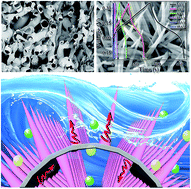Preparation of eggplant-derived macroporous carbon tubes and composites of EDMCT/Co(OH)(CO3)0.5 nano-cone-arrays for high-performance supercapacitors†
Abstract
A novel biomass-derived interconnected macroporous carbon tube structure was prepared for the first time by the freeze drying technique followed by carbonization of eggplant under N2. Unique Co(OH)(CO3)0.5 nano-cone arrays were grown on both sides of the thin walls of the macroporous carbon tubes by a simple one-step hydrothermal method without any additives. The obtained composites were used for supercapacitors, and showed high performance. The composite electrode exhibited an improved specific capacitance (2.6 times of the pure Co(OH)(CO3)0.5), good rate capability (retention up to 56% even at 40 A g−1), and cycle stability. It is speculated that the synergistic effect of highly graphitized macroporous carbon tubes and nano-array structures contributes to the fast electron transport and ion diffusion, thus improving the electrochemical performance. The composites prove to be promising materials for supercapacitors due to their easy availability, low cost and high performance.


 Please wait while we load your content...
Please wait while we load your content...